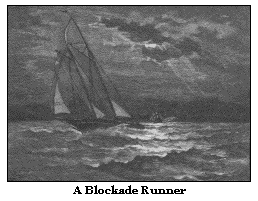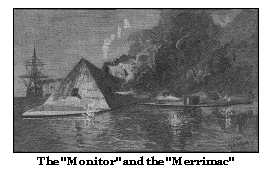

1. You must bear in mind that while the campaign for the opening of the Mississippi was in progress, the war was pushed in other quarters. We will go back, therefore, and give a history of the second great campaign of the Union
(200)
Events of 1862-1863. 201
leaders, --that was the recovery of the sea-coast from the Confederates. In pursuance of this purpose, the Union navy was increased and the southern ports blockaded.2. The English helped the Confederates to fit out a number of swift-sailing privateers, which dealt great injury to northern commerce. The most successful of them was the " Alabama," which destroyed many million dollars worth of property. She was sunk by the U. S. frigate "Kearsarge" (ke'ar-sarge) in June, 1864.
3. The blockade of the southern ports was made as effective as possible. It greatly crippled the strength of the South, although, with such an extended line of seacoast to guard, the steamers could not always prevent the swift craft of the Confederates from slipping out at night, or during a fog, and running back again in the darkness.
4. The war of the states brought about a revolution in naval warfare. The Confederates covered the outside of the steamer "Merrimac" with railroad iron, which sloped like the roof of a house. They then fixed an iron beak or prow to the strange craft.
5. One day the "Merrimac" moved slowly out from Norfolk, into Hampton Roads, to attack the Union vessels Iying there. She did not fire a gun, but steered straight for the sloop of war "Cumberland." The "Cumberland" fired her broadsides at the "Merrimac," but they bounded off like hailstones. (March, 1862)
6. Then the iron prow crashed into the "Cumberland," opening an enormous hole in her side. Through this the water poured like a mill-stream. The sloop of war quickly sank, her flag still fluttering from her mast-head above the surface, while the hull rested on the bottom.
202 Eclectic Primary History.
7. The frigate "Congress" saw it was impossible to resist the iron-coated craft, and she therefore ran ashore; but the "Merrimac" shelled her until she was forced to surrender. Then, having done so much damage, the "Merrimac" steamed back to Norfolk, intending to resume her work of destruction on the morrow.8. When she went back to Norfolk, it looked as if nothing could prevent her returning on the morrow and destroying the rest of the Union fleet. After that, she could go up the Potomac to Washington, or around by sea to Philadelphia and New York, and lay those cities under tribute, or cause such destruction as never was known.
9. But Captain Ericsson, of New York, had been hard at work, for a long time, on a vessel intended to beat off the "Merrimac." It was called the "Monitor," and was also sheathed with iron, but was only one fifth the size of the Confederate iron-clad. The "Monitor" reached Fortress Monroe on the night after the sinking of the "Cumberland."
10. The next morning the "Merrimac" steamed down from Norfolk to destroy the " Minnesota." (sic) The "Merrimac" boldly met her, and the two iron-clads were soon engaged in a furious battle. The "Monitor" was so much smaller than the "Merrimac," that she moved nimbly around her, firing her two immense guns as often as possible, and receiving no harm from her giant enemy. She was so effective indeed, that, after awhile, the "Merrimac" gave up the fight, and moved slowly back to Norfolk for repairs. She never was used again.
11. This battle, the first of its kind ever fought, ended the career of wooden frigates. Today the navies of the
Events of 1862-1863. 203

world are composed mainly of iron-clads. Our government began at once to build monitors, and for a brief while was the greatest of all naval powers.QUESTIONS 1. What was the second great campaign of the war? --2. What was done by the English? Which was the most successful? What became of her? --3. What is said of the blockade?--4. What revolution was brought about by the war of the states? Explain the construction of the "Merrimac". --5, 6. Give an account of the destruction of the "Cumberland"
7. What of the "Congress"? What did the "Merrimac" then do ? --8. What danger seemed to threaten? --9. What of the " Monitor"? --10. Describe the battle between the "Monitor" and "Merrimac." --11. What results followed from this battle?
© 1998, 1999, 2000, 2001 for the NEGenWeb Project by Ted & Carole Miller